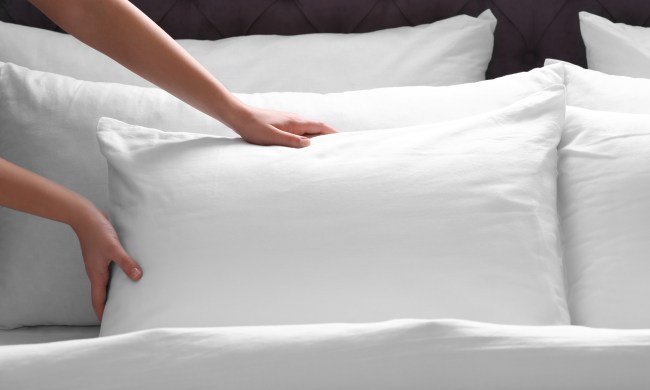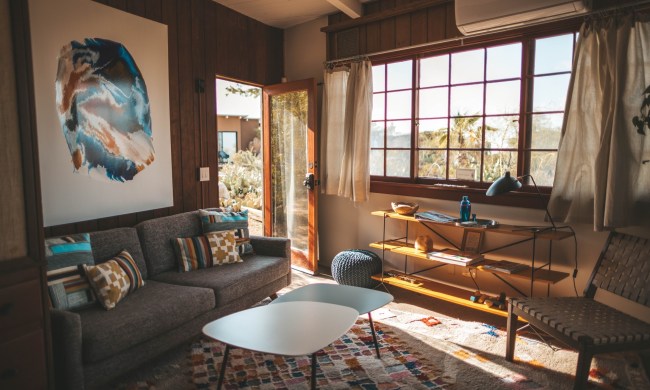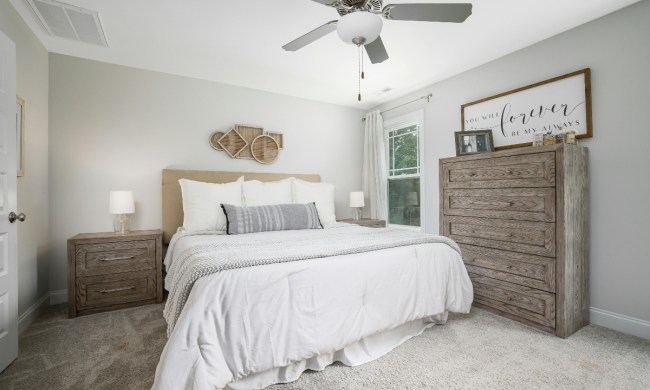You’ve probably seen a bunkie board without knowing the term. As an alternative to the traditional box spring, bunkie boards are another stabilizing support system for your mattress and can change up your night routine. Providing comfort, support, and more maneuverability, the bunkie board is a great choice for renters and those seeking an affordable bed solution. But what is a bunkie board? We’ll give you everything you need to know to make the best decision for your bed ensemble.
What is a bunkie board?

A bunkie board is a slimmer alternative to a box spring. It works in much the same way, providing structure to your mattress to aid in a more comfortable sleep.
Bunkie boards are often about 2 inches in height and can either slot into your bed frame or come with legs and supports. Bunkie boards can be one or two larger sheets of wood or plywood placed under your mattress. Or, you might see some metal and wooden bunkie boards with slats for stabilization.
The main draw of bunkie boards is their affordability and longevity. They provide adequate support for your mattress and can prevent sagging over time.
Types of bunkie boards for your bed

There are a few types of bunkie boards, though they mainly differ by material used rather than style or function.
Wood
Wood bunkie boards come in larger sheets and are quite durable. However, they can be more costly and heavier than other alternatives.
Plywood
Plywood bunkie boards can also be costly. However, they can come as one to two large boards or in slats, depending on the product. They may also be covered in thin fabric for heightened comfortability.
Particle board
Particle board bunkie boards are an affordable option. However, they aren’t necessarily the most durable or the best for the environment.
Metal
Metal bunkie boards are often made of steel. They are a durable and long-lasting option and are great for offering plenty of support. They are also lightweight and can sometimes fold up for easier maneuvering. However, they cannot support memory foam mattresses.
Bunkie board vs. Box spring

Bunkie boards and box springs are the most common choices for mattress support. They offer stability and a solid foundation for your mattress but have a few unique qualities that differ from one another.
Bunkie board
- Typically 2 inches tall, not including legs from the bedframe.
- Made from a sheet of plywood or wood or made of metal or wood slats.
- Lightweight and easy to move or disassemble.
- It’s a more affordable option than a box spring.
- It is not as sturdy as a box spring and prone to requiring tightening or repairs.
Box spring
- Typical box springs are around 9 inches tall, not including the bed frame.
- Box springs are made of wood, fabric, and spring coils.
- It’s much heavier than a bunkie board and can be more challenging to move.
- Box springs are more expensive than bunkie boards.
- It’s sturdier than a bunkie board but can get squeaky over time.
Pros of a bunkie board

If you’re considering a bunkie board in place of your box spring for your next purchase, consider these benefits.
- Supports the mattress: Bunkie boards are solid and sturdy. They prevent sagging and don’t wear down in the same way a box spring can.
- Compatible with most mattresses: Bunkie boards are compatible with most mattress types, including memory foam. Just avoid a slat bunkie board if you have a memory foam mattress.
- Cost effective: They are a much more budget-friendly option than a traditional box spring.
- Reduces bed height: Since bunkie boards are only about 2 inches in height, they can reduce the height of the bed, making it easier for kids, shorter adults, or those with mobility difficulties to crawl into.
- Lightweight and easy to move: Bunkie boards are lightweight and easy for homeowners to maneuver, making them great for kids’ rooms or apartments.
Cons of having a bunkie board

Before you make your decision, you’ll want to know the cons of owning a bunkie board.
- No bounce: The box spring gives the bed its classic “bounce.” However, bunkie boards don’t have springs, so the bed can feel more rigid and less flexible.
- Wood can warp: Wooden bunkie boards can wear down or warp over time. Temperature changes, liquid spills, and humidity can affect the boards.
- Little air circulation: Flat bunkie board sheets don’t allow for much circulation, which means you may find an accumulation of mold or mildew due to trapped moisture. Slats are more breathable.
- Lower bed height: The lower bed height can be difficult for some people and is not ideal for every household.
When should you choose to get a bunkie board?

Now that you know the difference between a bunkie board and a box spring, how do you know which is right for you? Here’s when to choose a bunkie board.
If you want to save money
Bunkie boards are the most cost-effective option. Buy a bunkie board if you need to save some money.
If you move your bed often
If you’re a renter, live in an apartment or dorm, or if you change up your room layout often, choose a bunkie board. It is more lightweight than a box spring and much easier to move.
If you prefer a lower mattress
Box springs add about 6 to 9 inches of height to your bed ensemble. If you want to lower your mattress, choose a bunkie board.
Bunkie boards are fantastic alternatives to the traditional box springs. They can be quite comfortable and come with some amazing benefits for those seeking to save money or who move homes frequently. If you’re looking for another solution for your bedroom, try a bunkie board and switch up your sleep routine.




